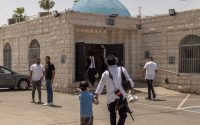Access to Food in Gaza is More Dire Than Ever
The flow of aid into Gaza has shrunk so much in May that humanitarian officials say their operations are at risk of shutting down, and that the threat of widespread starvation is more acute than ever.
Aid trucks entering Gaza fall far short of meeting need
The entry of aid trucks through Gaza’s southern crossings, where most aid has arrived since the war began, has nearly ground to a halt since Israel expanded its fighting in the southern city of Rafah. In northern Gaza, new entry points have enabled small amounts of critical aid to reach those who have been most at risk of famine for months. But that aid is insufficient to support the Gazan population, and most cannot reach the central and southern areas, where a majority of people are newly displaced by the war.
A ruling issued by the International Court of Justice on Friday appeared to order Israel to halt its military offensive in Rafah, although at least some of the court’s judges said limited operations could continue despite the decision. The ruling made explicit note of the “spread of famine and starvation” in Gaza and emphasized the need for “the unhindered provision at scale by all concerned of urgently needed basic services and humanitarian assistance.”
Last month, Israel had pledged to increase the aid it allowed into Gaza after the killing of seven World Central Kitchen workers in an attack by Israeli forces drew international outrage. Israel’s strict controls on aid and the challenge of distributing it within the enclave had already created catastrophic levels of hunger.
Under pressure from President Biden, Israeli officials began to bring additional aid through the port of Ashdod and opened the Erez crossing in the north, which Israel had closed after the Hamas attacks on Oct. 7. In coordination with Israel, the U.S. military built a temporary pier to bring in aid by sea, a supplement to key land routes in the south.
But in early May, Israel expanded its military operation in southern Gaza after a Hamas rocket attack killed four soldiers near a crossing at Kerem Shalom. Israel closed that crossing as well as the Rafah crossing, where a majority of aid had been coming in. Nearly 300 aid trucks had crossed there in a single day just before the incursion.
“It was a record for us since the outbreak of the war,” said Georgios Petropoulos, the head of the United Nations aid office in Rafah. “We were kind of saying, ‘OK, well, maybe we’re getting to where we need to be.’ And then boom, suddenly it’s gone.”
| Aid entrypoint | Current status |
|---|---|
| Rafah crossing | The crossing remains closed after it was seized and shut down by Israel during its incursion into Rafah. |
| Kerem Shalom crossing | Israel reopened this southern crossing on May 8, but a very limited amount of aid and fuel, and almost no medical supplies, have entered there since. |
| Erez and Erez West crossings | More aid has come through these crossings, which have been open since early May, than through others since May 8, but the amounts satisfy just a fraction of the overall need. |
| U.S.-built aid pier | The U.N. said on Wednesday that about 60 trucks’ worth of food has been delivered to warehouses via the pier, less than the U.S. military’s goal. Aid groups temporarily suspended distribution last week after security issues. |
| Airdrops | A few trucks’ worth of aid enters by air sporadically. |
Israel reopened Kerem Shalom on May 8, but aid workers from multiple organizations have said the vital entry point remains functionally closed, with a daily average of just eight aid trucks entering. One reason is that Egypt has refused to allow trucks from the closed Rafah crossing to continue on to Kerem Shalom.
President Biden and President Abdel Fattah al-Sisi of Egypt agreed on Friday to send aid and fuel to Kerem Shalom until the Rafah border crossing could be reopened. Roughly 200 trucks carrying food and other aid from Egypt were set to reach that crossing on Sunday, according to Ahmad Ezzat, an Egyptian Red Crescent official.
But not all 200 would enter Gaza right away, Scott Anderson, a senior official at UNRWA, said on Sunday. Mr. Anderson and Mr. Petropoulos have said that the crossing area is still an active military zone and that safety and logistical challenges can hold up aid that arrives at the crossing from being collected and distributed.
Empty trucks coming from inside Gaza en route to load aid at Kerem Shalom often sit in hours-long waits behind commercial trucks carrying goods to sell in Gaza, which officials say number more than 100 or 200 per day. While humanitarian groups say they welcome the arrival of commercial supplies, most people inside Gaza cannot afford them, and the shipments may not include basic necessities.
Getting aid to people in Gaza is also difficult because Israel’s expanded operations in the south and north have forced nearly a million people to flee to areas with little shelter, food or water on the coast or among the rubble in more central regions.
Before the Rafah operation, most people were sheltering in the areas where a majority of the aid was coming in. But now, new entry points in the north — the U.S. pier, and a new crossing called Erez West — are beset with problems. They bring in too little aid to sustain everyone and are located far from the largest clusters of people.
Before the Rafah operation
April 23 through May 6
After the Rafah operation
May 7 through May 20
The distribution of the aid that does make it through each crossing also poses significant challenges. Israel’s recent evacuation orders in parts of Rafah and northern Gaza have made many aid agency warehouses unreachable and travel more dangerous. The United Nations Relief and Works Agency for Palestine Refugees in the Near East, the main U.N. agency that aids Gaza, announced on May 21 that it had suspended distribution in Rafah, citing security issues, supply shortages and an inability to access its warehouse.
Without consistent, predictable deliveries of aid, many trucks do not make it far through desperate crowds. For instance, on May 18, the World Food Program reported that 11 of 16 trucks were looted after leaving the U.S. pier.
An Israeli military road and checkpoint in the north, which bisects the enclave and prevented the easy movement of aid from the south to the north earlier in the war, is likely to create a similar problem for aid moving in the opposite direction, according to Mr. Petropoulos.
COGAT, the Israeli military agency coordinating aid delivery, has said that increasing the amount of aid going into Gaza remains a priority. It reports daily that it has inspected hundreds of trucks and coordinated their transfer to border crossings, though the figures are often higher than those reported by aid organizations, which track the number of trucks that have collected goods for entry into Gaza and exclude trucks carrying commercial goods.
Neither set of figures accounts for difficulties in distribution that can prevent aid from getting to Gazan civilians. Israel says enough aid is entering Gaza and has blamed aid groups for not distributing it faster to civilians — a characterization the aid groups dispute, saying Israeli forces have made distribution extremely difficult.
Aid organizations have also warned that they will be unable to deliver supplies to anyone if they run out of fuel, and that already inadequate amounts of safe water supplies will disappear. At least 200,000 liters of fuel are needed daily, according to Mr. Anderson of UNRWA. But just a quarter of that amount arrives on average each day since the closure of Rafah crossing, according to U.N. data.
“The fuel limitation means that we often have to choose: Do we keep the generators running at the hospital, the bakery or the sewage plant?” Mr. Anderson said.
Methodology
Daily truck counts were compiled from multiple sources, including the U.N. dashboard for southern border crossings, meeting minutes from the inter-agency Logistics Cluster, World Food Program reports and updates from COGAT, the Israeli military agency coordinating aid delivery. The counts were cross-checked with multi-date aid truck totals from the U.N. Office for the Coordination of Humanitarian Affairs and the Office of the Spokesperson for U.N. Secretary-General.
Daily averages were calculated for the northern crossings from May 12 to May 15, as only a total count for that span of dates was available. Trucks carrying commercial goods are excluded.
Maps compare aid truck inflows over the two weeks before the Rafah operation and the two weeks after. Population estimates are based on reports by the United Nations, the Palestinian Central Bureau of Statistics and preliminary, internal estimates from aid organizations in Gaza. Estimates are based on satellite imagery analysis, field observations and shelter registrations, and are subject to change.


